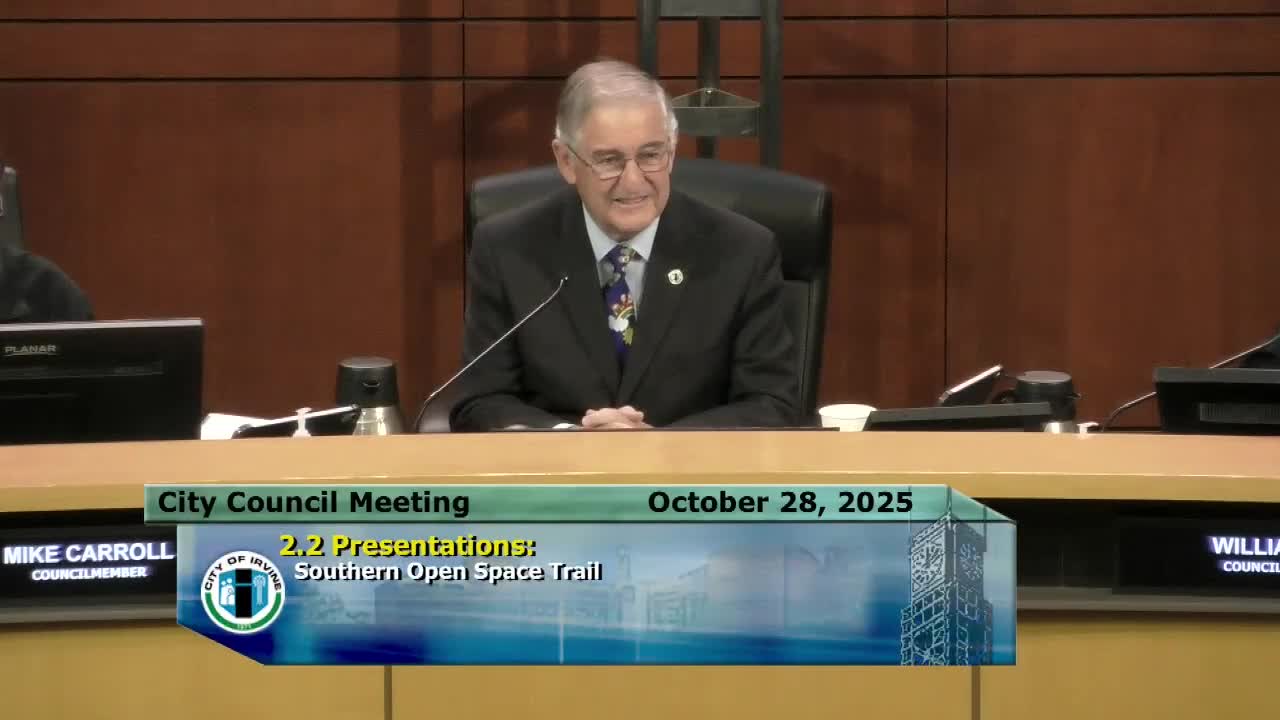Study finds moderate recreation and notable bird diversity in V‑Creek/Mule Deer open space; next steps proposed
October 28, 2025 | Irvine , Orange County, California
This article was created by AI summarizing key points discussed. AI makes mistakes, so for full details and context, please refer to the video of the full meeting. Please report any errors so we can fix them. Report an error »

City staff and the Irvine Ranch Conservancy presented a preliminary assessment on the feasibility of creating new trail connections in the V‑Creek and Mule Deer open‑space areas that could help complete a “mountains‑to‑sea” route linking Irvine’s open space to Laguna Coast and Crystal Cove.
The six‑month field effort used wildlife camera traps, human‑use cameras, trail counters and acoustic recorders to catalog wildlife and human activity. The consultants reported 1,193 trail‑counter events at V‑Creek and 1,204 in Mule Deer but stressed counts represent passage events, not unique users. Cameras recorded a mix of wildlife — coyotes, mule deer, raccoons and rabbits — and a very high avian diversity, with 62 bird species and seven federal‑ or state‑listed bird species detected in riparian areas. Acoustic monitoring also detected four bat species, including the western red bat (a California special‑concern species).
Human activity was described as “moderate” and concentrated at a handful of informal access points, particularly those that connect from Laguna Woods and Laguna Hills along Ridge Route and the gated access off Lake Forest Drive. The team documented both authorized uses (utility and OCFA access) and recurring trespass behaviors including motorcycles, fence‑hopping and social trails. Investigators also reported theft and vandalism of monitoring equipment (seven units lost), which reduced data from some locations.
Study authors and councilmembers noted that many sensitive resources are clustered in the riparian corridor — the same area where some existing infrastructure is located — which would require careful routing of any future trail to avoid habitat impacts. The consultants flagged several coordination challenges if the project advances: the southern parcels are not currently enrolled in the Natural Community Conservation Plan, and adjacent lands are owned or subject to conservation easements held by other agencies and the Nature Conservancy.
Councilmembers asked staff to return with options for next steps. Councilmember Mike Carroll, who requested the study, emphasized partnership opportunities and cultural‑heritage interpretation along the route. Staff said future planning would include stakeholder outreach and additional environmental review before any trail construction is proposed.
Why it matters: the assessment identifies both ecological sensitivity and physical opportunities for improved trail connectivity. The city and its partners must balance increased public access with protections for riparian habitat and listed species, and will need coordination with adjacent landowners and regional conservation programs before pursuing detailed design or permitting.
The six‑month field effort used wildlife camera traps, human‑use cameras, trail counters and acoustic recorders to catalog wildlife and human activity. The consultants reported 1,193 trail‑counter events at V‑Creek and 1,204 in Mule Deer but stressed counts represent passage events, not unique users. Cameras recorded a mix of wildlife — coyotes, mule deer, raccoons and rabbits — and a very high avian diversity, with 62 bird species and seven federal‑ or state‑listed bird species detected in riparian areas. Acoustic monitoring also detected four bat species, including the western red bat (a California special‑concern species).
Human activity was described as “moderate” and concentrated at a handful of informal access points, particularly those that connect from Laguna Woods and Laguna Hills along Ridge Route and the gated access off Lake Forest Drive. The team documented both authorized uses (utility and OCFA access) and recurring trespass behaviors including motorcycles, fence‑hopping and social trails. Investigators also reported theft and vandalism of monitoring equipment (seven units lost), which reduced data from some locations.
Study authors and councilmembers noted that many sensitive resources are clustered in the riparian corridor — the same area where some existing infrastructure is located — which would require careful routing of any future trail to avoid habitat impacts. The consultants flagged several coordination challenges if the project advances: the southern parcels are not currently enrolled in the Natural Community Conservation Plan, and adjacent lands are owned or subject to conservation easements held by other agencies and the Nature Conservancy.
Councilmembers asked staff to return with options for next steps. Councilmember Mike Carroll, who requested the study, emphasized partnership opportunities and cultural‑heritage interpretation along the route. Staff said future planning would include stakeholder outreach and additional environmental review before any trail construction is proposed.
Why it matters: the assessment identifies both ecological sensitivity and physical opportunities for improved trail connectivity. The city and its partners must balance increased public access with protections for riparian habitat and listed species, and will need coordination with adjacent landowners and regional conservation programs before pursuing detailed design or permitting.
View full meeting
This article is based on a recent meeting—watch the full video and explore the complete transcript for deeper insights into the discussion.
View full meeting
